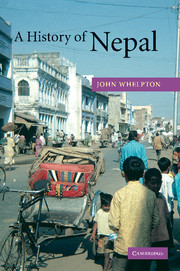Book contents
- Frontmatter
- Contents
- List of illustrations
- List of maps
- List of tables
- Key events
- Acknowledgements
- Notes on romanisation and terminology
- List of abbreviations
- Introduction
- 1 Environment, state and society in the central Himalayas to 1743
- 2 Unification and sanskritisation, 1743 – 1885
- 3 Nepal under the Shamsher Ranas, 1885 – 1951
- 4 The monarchy in ascendance: domestic politics and foreign relations, 1951 – 1991
- 5 The quest for ‘development’: economy and environment, 1951 – 1991
- 6 Lifestyles, values, identities: changes in Nepalese society, 1951 – 1991
- 7 Democracy and disillusionment: Nepal since 1991
- Genealogical tables
- Biographical notes
- Notes
- Glossary
- Bibliography
- Index
2 - Unification and sanskritisation, 1743 – 1885
Published online by Cambridge University Press: 05 June 2016
- Frontmatter
- Contents
- List of illustrations
- List of maps
- List of tables
- Key events
- Acknowledgements
- Notes on romanisation and terminology
- List of abbreviations
- Introduction
- 1 Environment, state and society in the central Himalayas to 1743
- 2 Unification and sanskritisation, 1743 – 1885
- 3 Nepal under the Shamsher Ranas, 1885 – 1951
- 4 The monarchy in ascendance: domestic politics and foreign relations, 1951 – 1991
- 5 The quest for ‘development’: economy and environment, 1951 – 1991
- 6 Lifestyles, values, identities: changes in Nepalese society, 1951 – 1991
- 7 Democracy and disillusionment: Nepal since 1991
- Genealogical tables
- Biographical notes
- Notes
- Glossary
- Bibliography
- Index
Summary
THE GORKHALI CONQUESTS: EXPANSION AND AFTERMATH
The single image most strongly associated with the history of modern Nepal is surely that of Prithvi Narayan Shah of Gorkha, girded for battle, a look of determination in his eyes and his right hand pointing skywards. This is his pose in the statue that stands outside the Government Secretariat in Kathmandu (illus. 3, p. 36) and in countless printed representations. Historians are rightly wary of making ‘great men’ the central focus of their analysis but in the case of Prithvi Narayan one individual did play a crucial role. Gorkha's rulers had long been intent upon expansion and Prithvi Narayan's father Narbhupal Shah had tried unsuccessfully to seize from Kathmandu the town of Nuwakot, which overlooked the Trisuli River which formed Gorkha's eastern boundary. It was Prithvi, however, who possessed both the ability and the determination to realise that ambition. From his accession in 1743, he fought continuously for control of the Kathmandu Valley, entering Kathmandu itself on 25 September 1768 and finally capturing Bhaktapur the following November. Between then and his death in 1775 he occupied all of eastern Nepal and much of modern Sikkim.
Prithvi's success rested partly on sound logistical preparations but even more on his political skills and a shrewd combination of conciliation and intimidation. He motivated his rank-and-file troops by offering them their own land assignments rather than relying on his officers raising and paying soldiers themselves. Most crucially, he took advantage of the rivalries between and within the Valley cities, where a sense of common ‘Newarness’, in so far as it existed at all, was not of great political importance. Non-Newar involvement in the Valley was nothing new, and Khasas had played an important role since the beginning of the seventeenth century. Gorkha itself had been a factor in intra-Valley politics for many years, and the Malla kings initially imagined that they could continue safely to make use of the Gorkhalis against each other, as they had made use of the Doyas in previous centuries. Consequently, apart from a brief period of united resistance in 1757, Kathmandu, Patan and Bhaktapur strove to reach separate accommodations with the Gorkhalis.
- Type
- Chapter
- Information
- A History of Nepal , pp. 35 - 60Publisher: Cambridge University PressPrint publication year: 2005

